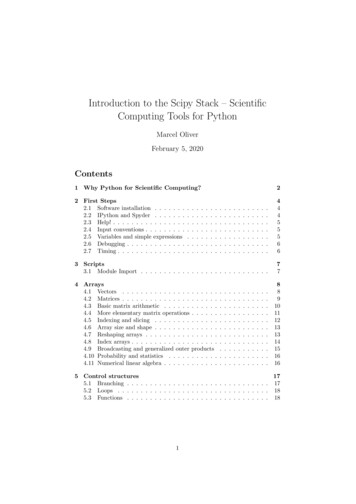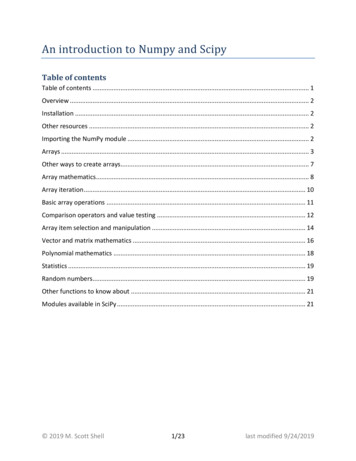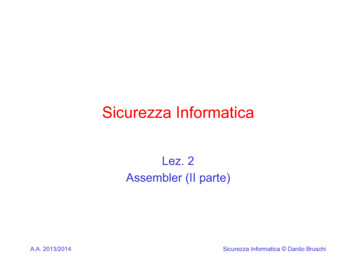
Transcription
Introduction to the Scipy Stack – ScientificComputing Tools for PythonMarcel OliverFebruary 5, 2020Contents1 Why Python for Scientific Computing?2 First Steps2.1 Software installation . . . . . . .2.2 IPython and Spyder . . . . . . .2.3 Help! . . . . . . . . . . . . . . . .2.4 Input conventions . . . . . . . . .2.5 Variables and simple expressions2.6 Debugging . . . . . . . . . . . . .2.7 Timing . . . . . . . . . . . . . . .2.444555663 Scripts3.1 Module Import . . . . . . . . . . . . . . . . . . . . . . . . . . . .77.4 Arrays4.1 Vectors . . . . . . . . . . . . . . . . . . . . .4.2 Matrices . . . . . . . . . . . . . . . . . . . . .4.3 Basic matrix arithmetic . . . . . . . . . . . .4.4 More elementary matrix operations . . . . . .4.5 Indexing and slicing . . . . . . . . . . . . . .4.6 Array size and shape . . . . . . . . . . . . . .4.7 Reshaping arrays . . . . . . . . . . . . . . . .4.8 Index arrays . . . . . . . . . . . . . . . . . . .4.9 Broadcasting and generalized outer products4.10 Probability and statistics . . . . . . . . . . .4.11 Numerical linear algebra . . . . . . . . . . . .8891011121313141516165 Control structures175.1 Branching . . . . . . . . . . . . . . . . . . . . . . . . . . . . . . . 175.2 Loops . . . . . . . . . . . . . . . . . . . . . . . . . . . . . . . . . 185.3 Functions . . . . . . . . . . . . . . . . . . . . . . . . . . . . . . . 181
6 Graphics6.1 Basic 2D graphs . . . . . . . .6.2 Labels, legends, and annotation6.3 Figure handling . . . . . . . . .6.4 3D Plots . . . . . . . . . . . . .7 Input and output7.1 Console I/O . . . . .7.2 Fancy formatting . .7.3 Plain text files . . .7.4 Saving numpy arrays7.5 Saving numpy arrays7.6 Reading CSV files .2020202121. . . . . . . . . . . . . . . . . . . . . .as text files .as .npz files. . . . . . . .21212222232323.8 Mutable and immutable objects9 Short self-contained examples9.1 Function plotting in 2D . . . . .9.2 Function plotting in 3D . . . . .9.3 Stability of multistep methods .9.4 Hilbert matrix . . . . . . . . . .9.5 Least square fit of a straight line9.6 Q-Q plot . . . . . . . . . . . . . .24.25252627293031AbstractOver the last 15 years, an enormous and increasingly well integratedcollection of Python-based tools for Scientific Computing has emerged—the SciPy Stack or short SciPy [7]. This document intends to provide aquick reference guide and concise introduction to the core components ofthe stack. It is aimed at beginning and intermediate SciPy users and doesnot attempt to be a comprehensive reference manual.1Why Python for Scientific Computing?Python is a full-fledged general-purpose programming language with a simpleand clean syntax. It is equally well suited for expressing procedural and objectoriented programming concepts, has a powerful standard library, numerous special purpose extension modules, and interfaces well with external code. Pythonis interpreted (strictly speaking, compiled to byte-code), ideal for interactiveexploration.As an interpreted language, Pythion cannot execute core numerical algorithms at machine speed. This is where NumPy comes in: since most large-scalecomputational problems can be formulated in terms of vector and matrix operations, these basic building blocks are provided with highly optimized compiledC or Fortran code and made available from within Python as array objects.Thus, any algorithm that can be formulated in terms of intrinsic operations onarrays will run at near-native speed when operating on large data sets. For thosespecial cases where this is insufficient, Python offers mechanisms for includingcompiled time-critical code sections, ranging from in-lining a few lines of C towrapping entire external libraries into Python.2
On top of NumPy, a collection of several large extension libraries createsa very comprehensive, powerful environment for Scientific Computing. SciPyextends the basic array operations by providing higher-level tools which coverstatistics, optimization, special functions, ODE solvers, advanced linear algebra, and more. Matplotlib is a plotting library which can create beautiful andvery flexible 2D graphics as well as basic 3D plots. IPython is indispensable asan interactive shell and provides a browser-based notebook interface. Furtherlibraries include pandas for data analysis, Mayavi for powerful 3D visualization,and SymPy for symbolic mathematics; many more specialized scientific librariesand applications are readily available on the net.At the same time, the whole universe of general-purpose Python extensionsis available to the SciPy developer. In particular, xlrd and xlwr allow readingand writing of Excel files and the csv module allows robust handling of CSVdata files. There are several comprehensive GUI toolkits, libraries for networkprotocols, database access, and other tools which help building complex standalone applications.This document focuses on the use of NumPy, the SciPy library, matplotlib,and IPython—together referred to as the SciPy Stack or simply SciPy [7]—forrapid prototyping of vectorizable numerical code. In this capacity, SciPy competes with Matlab, a proprietary development environment which has dominatedScientific Computing for many years but it is increasingly challenged by SciPyfor a number of reasons: Python is an appealing programming language. It is conceptually clean,powerful, and scales well from interactive experimentation all the way tobuilding large code bases. The Matlab language, on the other hand, wasoptimized for the former at the expense of the latter. SciPy is free software. You can run it on any machine, at any time, forany purpose. And, in principle, the code is fully transparent down tomachine level, which is how science should be done. Matlab, on the otherhand, must be licensed. Licenses typically come with number-of-CPUrestrictions, site licenses require network connection to the license server,and there are different conditions for academic and for commercial use.Moreover, its numerical core is not open to public scrutiny. (There isalso Octave, a free clone of Matlab. Unfortunately, it is strictly inferior toMatlab while sharing its conceptual disadvantages.) Numerical Python array objects work cleanly in any dimension. Powerful slicing and “broadcasting” constructs make multi-dimensional arrayoperations very easy. Matlab, on the other hand, is highly optimized forthe common one- and two-dimensional case, but the general case is lessidiomatic. matplotlib produces beautiful production-quality graphics. Labels can betransparently typeset in TEX, matching the rest of the document. In addition, there is great flexibility, e.g., for non-standard coordinate axes, nonnumerical graphical elements, inlays, and customized appearance. Matlabgraphics are powerful and well-integrated into the core system, but ratherless flexible and aesthetically appealing.3
So what are the drawbacks of SciPy? In practice, very few. Documentationis scattered and less coherent than Matlab’s. When working offline, the helpsystem is not always sufficient, especially if you do not know the precise nameof a function you are looking for. This is compensated, to some extend, by lotsof high quality resources on the internet. And this document tries to addresssome of the documentation gaps for newcomers to SciPy.For the simplest use cases, working in Python exacts a small tribute in theform of increased complexity (name space separation, call by reference semantics). However, in relation to the associated increase in expressive power, it isa very small price to pay and handled by Python in a minimally intrusive way.There are other considerations, both in favor of and against Python whichcan easily be found on the net. They are are mostly tied to specific domainsof application—the above is what matters most for general purpose ScientificComputing.2First Steps2.1Software installationUnless you have legacy code, install the stack based on Python 3. Python 2.7is increasingly unmaintained and should not be used. On Linux, install spyderwhich will pull in all the software you need. (yum install python3-spyder onRedhat-based and apt-get install python3-spyder on Debian-based distributions.)On Windows and MacOS, install the Anaconda Python distribution [4] (alsoavailable for Linux, but using distribution packages is often better).2.2IPython and SpyderThe Ipython shell The Ipython shell provides a powerful command line interface to the SciPy Stack. We always invoke it asipython3 --pylabThe command line option --pylab loads numpy and matplotlib into the globalname space. (In general, python modules must be loaded explicitly.) It alsomodifies the threading model so that the shell does not block on plotting commands.When writing scripts, you will have to load the modules you use explicitly.More on this in Section 3.1.The Spyder interactive development environment Spyder integrates atext editor, help browser, and interactive Ipython shell in one application. Makesure that the shell starts up with the --pylab option: Go to Tools–Preferences–Ipython console–Graphics and check the boxes “Activate support” and “Automatically load Pylab and NumPy modules”. You may also want to set “Backend” to “Automatic” to enable graphics in a separate window for zooming andpanning.4
2.3Help! help(name) explains the variable or function name. help() enters a text-based help browser, mainly useful for help on thePython language core. help(pylab) displays help information on Matlab-style plotting commands. quickref displays a summary of Ipython shell features.2.4Input conventions The default is one command per line without an explicit line terminationcharacter, but you may use ; to separate several commands within a line, \ to continue an expression into the next line; may be omitted if thecontinuation is unambiguous. Comments are preceded by #. Python is case-sensitive. Code blocks are grouped by level of indentation! See Section 5 on controlstructures below.Examples:In [1]: ’ab’ \.: ’cd’# Explicit line continuationOut[1]: ’abcd’In [2]: min(1,.:0) # Implicit line continuationOut[2]: 02.5Variables and simple expressions varname expression assigns the result of expression to varname. Some standard mathematical operators and functions: , -, *, /, **, sin,cos, exp, arccos, abs, etc. Comparison operators are , , , , , and ! . Boolean logical operators and, or, not. The operators & and represent bit-wise AND and OR, respectively!5
Examples:In [1]: 10**2 - 1e2Out[1]: 0.0In [2]: sqrt(-1)Out[2]: nanIn [3]: sqrt(-1 0j)Out[3]: 1jNote: The last example shows that you have to force the use of complex numbers. This behavior is different from Matlab.Warning: Python assignments are by reference! All assignment inPython is by reference, not by value. When working with immutable objects suchas numerical constants, Python automatically forces a copy, so the assignmentby-reference semantics is somewhat hidden. However, when working with mutable objects such as an array representing a vector or a matrix, one must forcea copy when required! This behavior is a source of hard-to-discover bugs andwill be discussed in detail in Section 8.2.6DebuggingSome commands useful for debugging: a? displays additional information on the object a, including documentation on the object class, if available. page displays the last output, page a displays the contents of a througha pager. Useful for investigating big arrays. Note: By default, pythonprints only the corners of arrays of size greater than 1000. To increasethis limit, use, e.g.,set printoptions(threshold 1000000) whos shows all user-defined variables and functions (see Section 5.3). , , refer to the previous, next previous, and next next previousoutput; Out[i] and In[i] refer to output cell i resp. input cell i. del a unbinds the variable a. reset unbinds all user-defined variables in the shell.Note: the commands above (except for del) are so-called Ipython magic functions. Should you happen to overwrite them with python function definitions,you still access them by prepending %.2.7TimingTo record the execution time of single code snippets or whole programs, severaloptions are available. For most purposes, timing from the Iphython shell suffices,but you can also put timing instrumentation into any program code.6
Timing code from the Ipython shellIn [1]: %timeit sum(arange(100))100000 loops, best of 3: 10.8 us per loopIn [2]: %timeit sum(arange(10000))10000 loops, best of 3: 33.1 us per loopSimple CPU-time stampimport timet time.process time()# Now do some big computationprint "Elapsed CPU Time:", time.process time() - tNote: use time.monotonic() instead of time.process time() if you need wallclock time.Timing short code snippets If you need a thorough analysis of small timecritical sections of code, use the timeit module:import timeitdef f(x):# do something which needs to be timedt timeit.Timer (’f(3.0)’, ’from main import f’)print ("1000 Evaluations take", t.timeit(number 1000), "s")Note: The timeit module runs f in a controlled environment, so you have to setup the environment with the import statement. If you need to pass variables asarguments, they need to be imported, too.3ScriptsExcept for very simple exploratory code, the normal workflow involves writingprogram code in separate text files and running them from the Ipython shell. Weonly discuss the case where the code is so simple as to be reasonably organizedin a single file. You can easily modularize larger projects; consult the Pythonlanguage documentation for details.Program files should, but need not, carry the suffix .py. It is commonpractice to start the first line with#! /usr/bin/env python3This allows direct execution of the file on Unix-like operating; on other operatingsystems, it is simply ignored.3.1Module ImportWhen working with script files, you are responsible for module loading. Onthe one hand, module import requires some explicit attention (“where is myfunction?!”). On the other hand, module namespaces provide sanity to complex7
projects and should be considered one of the strong points of working withPython.Since Python makes it is possible to import the same function or module indifferent ways, it is important to standardize on some convention. We suggestthe following:Short numerical codefrom pylab import *This import statement sets up a large set of basic, often Matlab-like functionsin the current namespace. It is the script file equivalent of starting the Ipythonshell with the pylab command line option as described in Section 2.2.If a more specialized function is required, we import it by its explicit nameinto the current namespace. E.g., we writefrom scipy.linalg import luto make available the function scipy.linalg.lu as lu. This convention keepsthe program code very close what you would do in the interactive shell afterinvoking ipython --pylab, and it also replicates Matlab to some extent.All examples in this document use this convention!Larger projects When working on large projects, library modules, or programs where only a small fraction of the code is numerical, we recommend usingfull module path names, respectively their commonly used abbreviations. E.g.,import numpy as npimport matplotlib.pyplot as pltimport scipy.linalgThen the common functions arange, figure, solve, all described further below,must be called as np.arange, plt.figure, and scipy.linalg.solve, respectively.4Arraysarray objects representing vectors, matrices, and higher-dimensional tensorsare the most important building blocks for writing efficient numerical code inPython. (numpy has an alternative matrix data type more similar to the Matlabmatrix model. However, its use is discouraged [6] and will not be discussed here.)4.1Vectors Define a vector v (1, 2, 3):v array([1,2,3]) Partition the interval [a, b] into n equidistant points:linspace(a,b,n) Partition the interval [a, b) into points with increment inc:arange([a,]b[,inc]) or r [a:b:inc]8
The same as an explicit column vector (n 1 matrix):c [a:b:inc] r [u,v] will concatenate the row vectors (one-dimensional arrays) u andv; c [u,v] will create a matrix with columns u and v. Arrays have a fixed data type. You can specify a data type with the dtypeargument upon array creation. Common data types are float, complex,int, long (64-bit integer), bool.Examples:In [1]: linspace(0,1,5)Out[1]: array([ 0. , 0.25,0.5 ,0.75,In [2]: arange(0,1,0.25)Out[2]: array([ 0. , 0.25,0.5 ,0.75])1.])In [3]: arange(5)Out[3]: array([0, 1, 2, 3, 4])In [4]: arange(1,6)Out[4]: array([1, 2, 3, 4, 5])In [5]: arange(1,6,dtype float)Out[5]: array([ 1., 2., 3., 4.,5.])Note that arange follows the general Python convention of excluding theend point. The advantage of this convention is that the vector arange(a,b)has b a components when this difference is integer.4.2Matrices 1A matrix A 324 is generated as follows.In [1]: A array([[1,2],[3,4]]); AOut[1]:array([[1, 2],[3, 4]])Matrices can assembled from submatrices:In [2]: b c [5:7]; M c [A,b]; MOut[2]:array([[1, 2, 5],[3, 4, 6]])In [3]: M r [A,b[newaxis,:]]; MOut[3]:array([[1, 2],[3, 4],[5, 6]])9
Special Matrices There are functions to create frequently used m n matrices. If m n, only one argument is necessary. eye(m,n) produces a matrix with ones on the main diagonal and zeroselsewhere. When m n, the identity matrix is generated. rand(m,n) generates a random matrix whose entries are uniformly distributed in the interval (0, 1). zeros((m,n)) generates the zero matrix of dimension m n. ones((m,n)) generates an m n matrix where all entries are 1. diag(A) creates a vector containing the diagonal elements ajj of the matrix A. diag(v) generates a matrix with the elements from the vector v on thediagonal. diag(v,k) generates a matrix with the elements from the vector v on thek-th diagonal.4.3Basic matrix arithmetic The usual operators , -, and *, etc., act element-wise. A.T denotes the transpose of A. A.conj().T conjugates and transposes A. dot(A,B) computes the matrix product AB of two matrices A and B. A@v or dot(A,v) computes the product of a matrix A with a vector v.Examples:In [1]: A array([[1,2],[3,4]]); A-A.TOut[1]:array([[ 0, -1],[ 1, 0]])In [2]: A*A.T # Element-wise productOut[2]:array([[ 1, 6],[ 6, 16]])In [3]: A@A.T # Matrix productOut[3]:array([[ 5, 11],[11, 25]])10
Vector products If the column vectors v, w Rn are represented by onedimensional arrays v and w, then v@w or dot(v,w) computes the inner product v T w; c [v]@r [[w]] or outer(v,w) computes the outer product vwT .Sums and products over array elements sum(A) computes the sum of all elements of A. sum(A,axis i) computes the sum along axis i of the array. cumsum, prod, and cumprod follow the same pattern for cumulative sums(an array with all stages of intermediate summation), products, and cumulative products. trace(A) or A.trace() yields the trace of a matrix A.Note that the first axis (row indices for matrices) corresponds to axis 0, thesecond (column indices for matrices) corresponds to axis 1, etc.ExamplesIn [1]: A array([[1,2],[3,4]]); sum(A)Out[1]: 10In [2]: sum(A,axis 0)Out[2]: array([4, 6])In [3]: sum(A,axis 1)Out[3]: array([3, 7])In [4]: cumprod(A)Out[4]: array([ 1,2,6, 24])You can compute with Booleans where False 0 and True 1. So thefollowing expression counts the number of nonzero elements of a matrix:In [4]: A eye(3); sum(A! 0)Out[4]: 34.4More elementary matrix operations amax(A) or A.max() finds the maximum value in the array A. You can addan axis argument as for sum. argmax(A) or A.argmax() returns the index relative to the flattened arrayA of only the first element which takes the maximum value over the array.Works also along a specified axis. fmax(A,B) element-wise max functions for two arrays A and B. There is a corresponding set of min-functions.11
allclose(A,B) yields true if all elements of A and B agree up to a smalltolerance. around(A,decimals n) or A.round(n) rounds the elements of A to ndecimal places.ExamplesIn [1]: A array([[1,2],[3,4]]); amax(A); argmax(A)Out[1]: 4Out[1]: 3In [2]: A.flatten()[argmax(A)]Out[2]: 4In [3]: B 3*eye(2); argmin(B,axis 1)Out[3]: array([1, 0])In [4]: fmax(A,B)Out[4]:array([[ 3., 2.],[ 3., 4.]])4.5Indexing and slicingPython indexing starts from zero! This is often different from traditional mathematical notation, but has advantages [1].ExamplesIn [1]: A array([[1,2],[3,4]]); A[0,0]Out[1]: 1In [2]: A[1]Out[2]: array([3, 4])In [3]: A[:,1]Out[3]: array([2, 4])Ranges a:b specifies the index range a i b. Negative values count from theend of the array. a:b:s is the same in steps of s. When s is negative, the order is reversed. delete(A,i,axis) deletes the subarray of index i with respect to axisaxis.12
ExamplesIn [1]:Out[1]:Out[1]:Out[1]:a arange(5); a[2:]; a[-3:]; a[::-1]array([2, 3, 4])array([2, 3, 4])array([4, 3, 2, 1, 0])In [2]: A eye(4, dtype int); A[1:3,:3] -8; AOut[2]:array([[ 1, 0, 0, 0],[-8, -8, -8, 0],[-8, -8, -8, 0],[ 0, 0, 0, 1]])In [3]: A[1:3,1:3] Out[3]:array([[ 1, 0, 0,[-8, 0, 1,[-8, 1, 0,[ 0, 0, 0,4.6eye(2, dtype int)[::-1]; A0],0],0],1]])Array size and shape A.shape returns a python tuple containing the number of elements in eachdimension of the array A. A.size returns the total number of elements of A. len(A) returns the number of elements of the leftmost index of A.ExamplesIn [1]: A eye(3); A.shapeOut[1]: (3, 3)In [2]: A.sizeOut[2]: 9In [3]: len(A)Out[3]: 34.7Reshaping arrays A.reshape(i,j,.) transforms A into an array of size (i,j,.). Thetotal size must remain unchanged. A.flatten() flattens A into a 1-dimensional array.Examples13
In [1]: AOut[1]:array([[[[[ arange(12); B A.reshape(2,3,2); B0,2,4,1],3],5]],[[ 6, 7],[ 8, 9],[10, 11]]])In [2]: B.flatten()Out[2]: array([ 0, 1,4.82,3,4,5,6,7,8,9, 10, 11])Index arraysA powerful way to write short, elegant code is to use arrays of integers orBooleans to index other arrays. Though our examples only scratch the surface,many tricky index problems can be solved this way! v[i], where i is a one-dimensional integer array, yields an array of lengthlen(i) containing elements vi1 , vi2 , . . . . More generally, A[i,j,.] gives an array of shape i.shape which mustcoincide with j.shape, etc., with elements picked from A according to theindices at each position of i, j, etc. A[b], where b is a Boolean array of the same shape as A selects thosecomponents of A, for which b is true.ExamplesSelect every second element from an array a:In [1]: a 2**arange(8); aOut[1]: array([ 1,2,4,8,16,32,64, 128])In [2]: i 2*arange(4); iOut[2]: array([0, 2, 4, 6])In [3]: a[i]Out[3]: array([ 1,4, 16, 64])Note: this particular example is equivalent to a[::2], but the index arrayconstruct is much more general.In two dimensions, index arrays work as follows. As an example, we extractthe main anti-diagonal of the matrix A:In [4]: A arange(16).reshape(4,4); AOut[4]:array([[ 0, 1, 2, 3],[ 4, 5, 6, 7],[ 8, 9, 10, 11],[12, 13, 14, 15]])14
In [5]: i arange(4); j i[::-1]; A[i,j]Out[5]: array([ 3, 6, 9, 12])Set all zero elements of A to 2:In [6]: A eye(3, dtype int); A[A 0] 2; AOut[6]:array([[1, 2, 2],[2, 1, 2],[2, 2, 1]])4.9Broadcasting and generalized outer productsWhen performing element-wise operations on a pair of arrays with a differentnumber of axes, Numpy will try to “broadcast” the smaller array over the additional axis or axes of the larger array provided this can be done in a compatibleway. (Otherwise, an error message is raised.)ExampleIn [1]: A ones((3,3)); b arange(3); A*bOut[1]:array([[ 0., 1., 2.],[ 0., 1., 2.],[ 0., 1., 2.]])The detailed general rules can be found in the Numpy documentation [5]. However, you can also explicitly control how broadcasting is done by inserting thekeyword newaxis into the index range specifier to indicate the axis over whichthis array shall be broadcast. The above example is equivalent to the following.In [2]: A*b[newaxis,:]Out[2]:array([[ 0., 1., 2.],[ 0., 1., 2.],[ 0., 1., 2.]])In the same way, we can have b be broadcast over columns rather than rows:In [3]: A*b[:,newaxis]Out[3]:array([[ 0., 0., 0.],[ 1., 1., 1.],[ 2., 2., 2.]])Finally, a more complicated example using explicit broadcasting illustrates howto compute general outer products for tensors of any shape:In [4]: A array([[1,2],[3,5]]); b array([7,11]); \.: [ 7, 14],[11, 22]],[[21, 35],[33, 55]]])15
4.10Probability and statistics mean(a), var(a), and std(a) compute mean, variance, and standard deviation of all array elements of the array a. To compute them only alonga specified axis, add an axis-argument as described in Section 4.3. random(shape) produces an array of random numbers drawn from a uniform distribution on the interval [0, 1) with specified shape. normal(m,s,shape) produces an array of random numbers drawn from anormal distribution with mean m and standard deviation s with specifiedshape. Similarly, you can draw from a binomial, poisson, or exponential distribution. Consult the help system for information on parameters.4.11Numerical linear algebraThe following numerical linear algebra functions are loaded into the globalnamespace when you import pylab. solve(A,b) yields the solution to the linear system Ax b. inv(A) computes the inverse of A. d,V eig(A) computes a vector d containing the eigenvalues of A and amatrix V containing the corresponding eigenvectors such that AV V Dwhere D diag d. U,s,Vh svd(A) computes the singular value decomposition of A. Returned are the matrix of left singular vectors U , the vector of corresponding singular values, and the Hermitian complement of the right singularvectors V H Vh. Then A U SV H where S diag s. Q,R qr(A) computes the QR-decomposition QR A. norm(A) computes the Frobenius norm of an array A of any dimension;if A is a matrix, norm(A,p) computes the operator p-norm, p can onlytake the values 1, 2 or inf; if v is a one-dimensional array, norm(v,p)computes the vector p-norm. cond(A) computes the condition number of A with respect to the 2-norm.ExamplesIn [1]: A array([[0,1],[-2,0]]); eig(A)Out[1]:(array([ 0. 1.41421356j, 0.-1.41421356j]),array([[ 0.00000000-0.57735027j, 0.00000000 0.57735027j],[ 0.81649658 0.j, 0.81649658 0.j]]))In [2]: d,V eig(A); allclose(dot(A,V), dot(V,diag(d)))Out[2]: True16
In [3]: svd(A)Out[3]:(array([[ 0., 1.],[ 1., 0.]]),array([ 2., 1.]),array([[-1., -0.],[ 0., 1.]]))In [4]: U,s,Vh svd(A); allclose(dot(dot(U,diag(s)),Vh),A)Out[4]: TrueThe scipy.linalg module contains many more specialized numerical linearalgebra routines such as LU and Cholesky factorization, solvers for linear systems with band-matrix structure, matrix exponentials, the conjugate gradientmethod, and many more. To get an overview, typeIn [1]: from scipy import linalgIn [2]: help linalgSingular linear systems Contrary to Matlab behavior, solve(A,b) exitswith an error message when the matrix A is singular. If you need a least-squareor least-norm solution, you have to use lstsq from scipy.linalg. This isillustrated in the following:In [1]: A array([[1,0],[0,0]]); b array([1,0]); c b[::-1]In [2]: x solve(A,b)LinAlgError: Singular matrixIn [3]: from scipy.linalg import lstsqIn [4]: x, res, rk, s lstsq(A,b); xOut[4]: array([ 1., 0.])This example is an underdetermined system; any vector x (1, α) would solvethe system. lstsq returns the least-norm solution as well as the residual res,the effective rank of the matrix rk, and the vector of singular values s. Whenthe system is inconsistent, the least-square solution is returned:In [5]: x, res, rk, s lstsq(A,c); xOut[5]: array([ 0., 0.])5Control structures5.1BranchingConditional branching works as follows:if i 2:print("i is less than 2")17
elif i 4:print("i is greater or equal to 4")else:print("i is greater or equal to 2 and less than 4")5.2LoopsA simple “for-loop” in Python works as follows, with the usual conventions forthe range specifier.In [1]: for i in range(3,5):.:print(i)34Iterators More generally, Python loops can iterate over many list-like objectssuch as arrays:In [1]: a exp(0.5j*pi*arange(4))In [2]: for x in a:.:print(x)(1 0j)(6.12303176911e-17 1j)(-1 opsHere is an example of a while-loop:x 5while x 0:print(x)x - 1More flow control Use break to leave the innermost loop (or, more generally, the innermostscope); Use continue to go to the next iteration of the loop without evaluatingthe remainder of its body; A loop can have an else:-clause which is run after a loop terminatesregularly, but will not be run if the loop is left via a break-statement.5.3FunctionsFunctions are defined with the keyword def.18
ExampleIn [1]: def square(x):.:return x*xIn [2]: square(5)Out[2]: 25Note: If a function does not take any arguments, its definition must still end withparentheses. Functions do not need to return anything; the return keyword isoptional. Variables used within a function are local —changing them locally doesnot change a possibly globally defined variable of the same name.Warning: References are local, not the data! If you pass a reference toa mutable object as a function argument, you can still modify its data fromwithin the function even though you cannot modify the reference pointer itself.However, immutab
quick reference guide and concise introduction to the core components of the stack. It is aimed at beginning and intermediate SciPy users and does not attempt to be a comprehensive reference manual. 1 Why Python for Scienti c Computing? Python is a full-edged general-purpose programming language with a simple and clean syntax.










